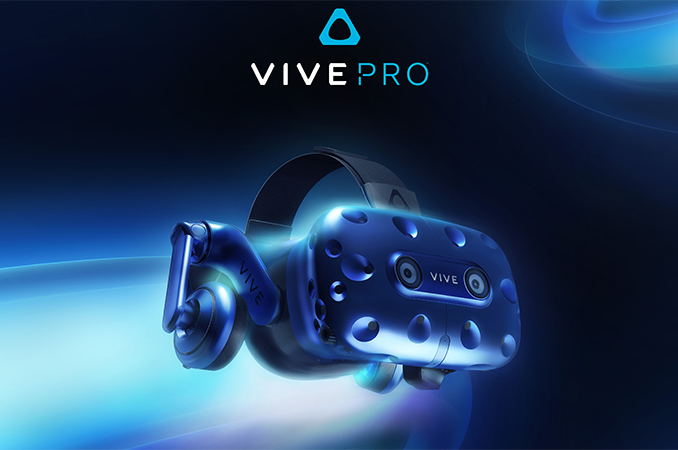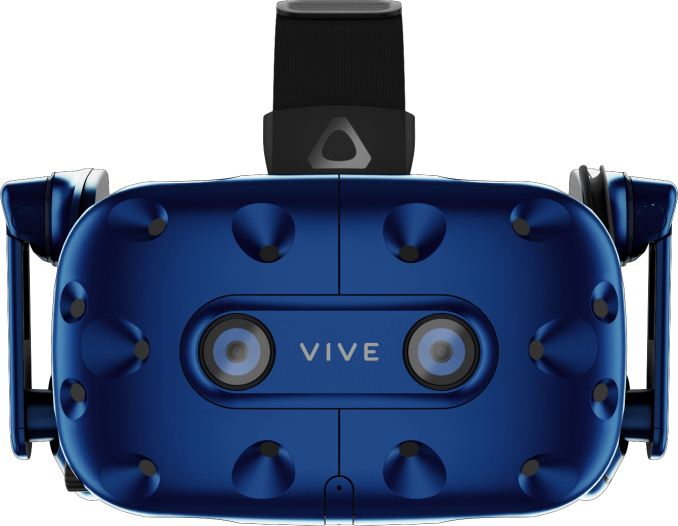HTC at CES 2018: Vive Pro VR Headset with Higher-Res Displays, Two Cams, Headphones
by Anton Shilov on January 8, 2018 7:30 PM EST
LAS VEGAS, NV — HTC today announced its next-generation Vive Pro VR headset at CES 2018. The new head-mounted display will have several noticeable improvements over the existing Vive: it will feature higher-resolution displays, a redesigned headstrap, built-in headphones as well as two microphones and two front-facing cameras. The new unit will retain backward compatibility with tracking and gaming peripherals for the original Vive and be available in the coming months.
The new HTC Vive Pro VR HMD is equipped with two OLED screens featuring a 2880×1600 combined resolution (1440×1600 per eye, 615 PPI), which means that the new headset displays 78% more pixels than its predecessor, significantly increasing picture quality. The resolution increase leaps the Vive Pro ahead of the Oculus Rift as well as Windows Mixed Reality headsets in terms of graphics quality. It should be noted that the extra pixels will require additional graphics processing horsepower, so the new Vive Pro headset might need a more powerful system than the original Vive to offer a decent user experience. Meanwhile, HTC says nothing about Vive Pro’s refresh rate and field-of-view and it remains to be seen whether we are going to see any improvements on these fronts with the Vive Pro.
Another significant upgrade of the HTC Vive Pro is built-in headphones featuring an integrated amplifier to guarantee an improved audio quality as well as two microphones for enhanced noise cancellation. HTC does not quantify improvements, so it is impossible to tell whether the headphones are any better than mainstream ones from known brands, but integration of the headset will clearly make the setup a bit cleaner and more comfortable to use now there is one less cord to plug. Speaking of comfort, the new Vive Pro also features a revamped headstrap with enhanced ergonomics that balance the weight of the headset and features a special sizing dial.
The upcoming HTC Vive Pro headset also has two front-facing cameras instead of one on the original Vive. HTC does not disclose the purpose of the second camera but only says that “it is designed to empower developer creativity”. Keeping in mind that HTC is working with different developers on various projects, including integration of real physical objects into virtual worlds, the additional cam may come in handy. Meanwhile, two cameras can also be used to improve position tracking.
HTC does not announce pricing and exact retail launch date of the Vive Pro headset just yet but only says that more details will be released soon. The Verge reports that the Vive Pro will be available to existing customers already this quarter.
Related Reading:
- HTC Permanently Cuts Price of Vive to $599
- HTC Announces Standalone Vive Focus with 6DoF Tracking, Cancels Daydream VR Headsets
- North American Pre-Orders Opened for TPCast’s Wireless Adapter for HTC Vive
- Logitech and HTC Team Up to Integrate Physical Keyboards Into VR Environments
- HTC Vive Launch Day News & First Impressions
- Futuremark To Release VRMark Cyan Room on November 22: A DX12 VR Benchmark
Source: HTC



















29 Comments
View All Comments
Danvelopment - Monday, January 8, 2018 - link
2 = Better product, same or better pricePro = Better product, worse price
Looks like I won't be going VR yet.
shabby - Monday, January 8, 2018 - link
"two OLED screens featuring a 2880×1600 combined resolution"Hmm i tried gear vr on my s8 that has a 2960x1440 screen and everything looked like the first sea turtle, is htc doing something special here with that pentile oled display or is it just marketing?
nathanddrews - Tuesday, January 9, 2018 - link
Probably one part marketing (example: static images showing the the difference between 1080p and 4K televisions) and the other part being the rendering power of your S8 phone versus the rendering power of a 1080Ti.shabby - Tuesday, January 9, 2018 - link
No doubt the 1080ti had more horsepower but the pentile screen door effect was clearly visible on the s8, better gpu won't help. Never tried these standalone vr units so it would be nice to compare.eoffermann - Tuesday, January 9, 2018 - link
The screen door effect isn't much helped by improving screen resolution (at least not by improving screen resolution alone). For comparison, PSVR has reduced screen door effect compared to current Vive despite having a lower resolution display. The problem isn't the pixels - it's the space between the pixels. If you built a display with solid rectangular pixels that touched the adjacent pixels, there would be no screen door effect even if the resolution was only a hundred pixels across.theuglyman0war - Wednesday, January 17, 2018 - link
If we are going to qualify the screen door effect as annoyance at seeing the lines/grid alone...Then the heck with the screen door effect...
Even the sub pixel "grain" grates on my nerves leaving me wanting more fidelity before I subscribe at the high entry cost.
I consider myself rabidly interested in all experiences that are immersive and stereoscopic but aside from demoing each new device...
I have yet to open my wallet at these prices on an experience that comes close to a realistic value for the experience we are asked to suffer ( except for the trivial cost of second gear VR at $30 bucks )
Same as all display devices lately...
The aging tech like oled and hdr at qhd and uhd has been absent or at an insane premium for far to long.
Wish there was a final notification app to inform us when the industry is finished string us along.
OLED and HDR will be a flexible ubiquitous acetate sticker ( thus at a negligible price ) in about 4 years when it should had been so 6 years ago considering the flexi-poster oled has been touted for the past 15 years.
Every CES same damn thing...
Still at a premium?
Did VIVE Pro REALLY need 2 years to be released? It's simply an iteration?
smh...
The Samsung Odessey sound interesting so long as that initial price drops quickly enough.
I might finally buy in to VR with the Samsung as a temp measure till the VR experience is primetime.
( Not likely anytime soon. Lackluster Vega means the Volta touted 2 years ago while Pascal was parked in it's place. Didn't have to be released any time soon )
Feeling strung along?
Nvidia can release a GTX 1080 ti Pro now I suppose?
Promote that release with a free version of next gen Vaseline.
Manch - Tuesday, February 6, 2018 - link
In regards to all of them you really have to be focusing on the subpixels or in a completely whitish gray room to really notice it. Also, if it bothers you, you can adjust the focal length to soften the image. PSVR uses software to do this and really blurs the crap out of the image to reduce the effect. Granted on any of them its an already soft image but this is hardly a deal breaker. Both Vive and Oculus use similar diamond pentile which diffuse the subpixel distance relatively evenly. PSVR has a wider horizontal distance vs vertical. That being said, increasing resolution/pixel density on a given sized panel correlates to decreased subpixel spacing so increasing the resolution will help.Yojimbo - Monday, January 8, 2018 - link
2 is a replacement and pro exists alongside. The price has come down so much at launch the pro will probably launch at a lower price than a "2" will when it launches. "2" will have features like eye tracking, a wider field of view, and possibly even some system to mitigate the vergence-accomodation conflict.Pinn - Tuesday, January 9, 2018 - link
what? very confusing. this is just the second generation. the third generation will have backwards compatibility too. pricing is irrelevant. you'll want the pro. you'll want the "2".Danvelopment - Tuesday, January 9, 2018 - link
My point is they called it the Pro (which is really the 2) so that they didn't have to drop the price.